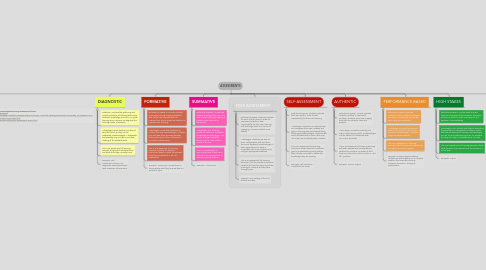ASSESSMENTS
by Sharlitta Myrick

1. DIAGNOSTIC
1.1. Definition: Involves the gathering and careful evaluation of detailed data using students' knowledge and skills in a given learning area. Purpose: To diagnose the learning needs of students.
1.2. Advantages: Gives teachers an idea of what the need, so they can be addressed. Disadvantages: A diagnostic test possibly may not get an accurate reading of the students skills.
1.3. This is an assessment of learning because it tests what students know and what skills they currently have.
1.4. Example: The Woodcock-Johnson is a diagnostic assessment which tests academic achievement.
2. SUMMATIVE
2.1. Definition/Purpose: to evaluate student learning at the end of an instructional unit by comparing it against some standard or benchmark
2.2. Advantages: Can show the growth or decline of a students knowledge Disadvantages: Can render anxiety in students because of the "high stakes" nature of the test
2.3. This is an assessment of learning because it tests what students have learned over an extended period of time.
2.4. Example: A final exam
3. HIGH STAKES
3.1. Definition/Purpose: Any test used to make important decisions about students, educators, schools, or districts, most commonly for the purpose of accountability.
3.2. Advantages: Let's schools and districts know how they are doing in comparison to other schools and districts around the country. Disadvantages: Can be the only determining factor for students learning and may not necessarily be accurate.
3.3. This is an assessment of learning because it tests what students have learned over the course of a school year.
3.4. Example: PARCC
4. FORMATIVE
4.1. Definition/Purpose: To monitor student learning to provide ongoing feedback that can be used by instructors to improve their teaching and by students to improve their learning.
4.2. Advantages: Immediate feedback on student learning Disadvantages: Students may not take them seriously because they are low point value compared to summative assessments
4.3. This is an assessment for learning because it guides the teachers instruction based on what the student show they understand or do not understand
4.4. Example: Drawing a concept map to demonstrate what they learned about a particular topic
5. PERFORMANCE BASED
5.1. Definition/Purpose: Requires students to demonstrate knowledge and skills, including the process by which they solve problems.
5.2. Advantages: Ensures that students know the process for reaching an outcome Disadvantages: May take longer to assess students
5.3. This is an assessment of learning because it tests the process students go through to arrive at an answer.
5.4. Example: Group projects enabling students to work together on a complex problem that requires planning, research, discussion, and group presentation.
6. PORTFOLIO
6.1. Definition/Purpose: A collection of student work created in response to specific, known instructional objectives and evaluated in relation to the same criteria.
6.2. Advantages: Student progress can be easily seen over the course of a set period of time. Disadvantages: The assessment for learning isn't immediate. It must be accompanied with other types of assessment.
6.3. This is an assessment of learning because it shows what students have learned over a period of time.
6.4. Example: Writing samples over the course of the entire school year
7. AUTHENTIC
7.1. Definition/Purpose: Aims to evaluate students' abilities in 'real-world' contexts. Students learn how to apply their skills to authentic tasks and projects.
7.2. Advantages: Promotes creativity and higher order thinking skills. Disadvantages: Can be difficult to coordinate with curriculum standards
7.3. This is an assessment of learning because authentic assessments usually require students to combine a number of skills they have learned in order to solve a "real life" problem
7.4. Example: Science project
8. SELF-ASSESSMENT
8.1. Definition/Purpose: Students evaluate their own work in order to take responsibility for their own learning
8.2. Advantages: Students can self-evaluate and recognize their own mistakes and gaps in learning and work toward filling those gaps Disadvantages: Students who aren't provided with a clear rubric may not know how to identify their mistakes
8.3. This is an assessment for learning because it allows students to see their gaps in understanding and it pushes them to take measures to obtain the knowledge they are missing
8.4. Example: Self-evaluation checklist for an essay
9. PEER ASSESSMENT
9.1. Definition/Purpose: Students evaluate the work of their peers in order to empower students to take responsibility for their own learning and exchange ideas as a means of engaging in course material more deeply
9.2. Advantages: Students are able to learn collaboration skills and learn from peer feedback Disadvantages: If clear expectations for what is acceptable aren't set, students may not give appropriate feedback
9.3. This is an assessment for learning because it lets the teacher know what students still need to learn and allows learning to continue to take place through peers
9.4. Example: Peer editing of the first draft of an essay
10. References
10.1. http://edglossary.org/high-stakes-testing/ http://www.projectappleseed.org/#!assessment/cwvf https://educ6040fall10.wikispaces.com/Authentic+Assessment https://www.google.com/search?q=portfolio+assessment&oq=portfolio+assessment&aqs=chrome..69i57j0l5.4843j0j7&sourceid=chrome&es_sm=93&ie=UTF-8 https://www.cmu.edu/teaching/assessment/basics/formative-summative.html http://everydaylife.globalpost.com/advantages-disadvantages-formative-assessment-28407.html


